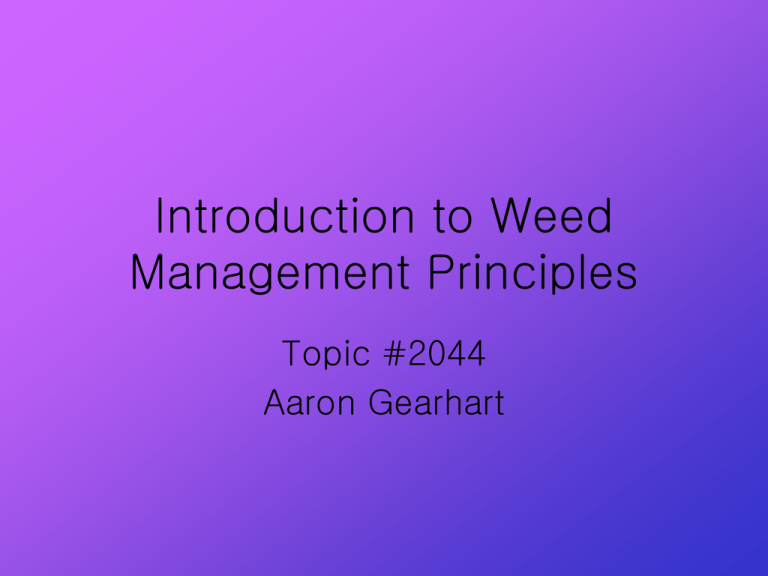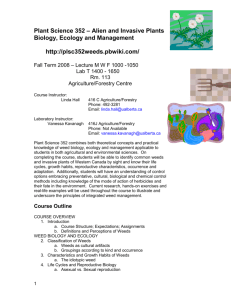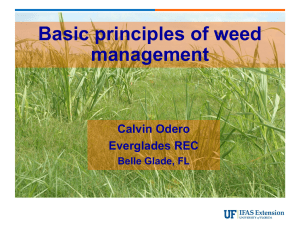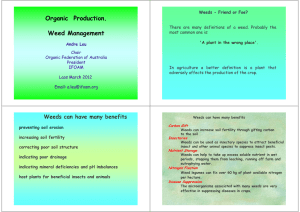Introduction to Weed Management Principles
advertisement

Introduction to Weed Management Principles Topic #2044 Aaron Gearhart What is a Weed? • Any plant can be a weed under the right circumstances • Corn example • Soybean example • It all depends on what type of production you are trying to accomplish Why care? • • • • Food costs Aquatic nuisance Allergies Hosts for diseases and insects Dandelion http://www.noble.org/imagegallery/Forbhtml/Dandelion.html Why care? • Increased soil erosion • Decreased amount of food we can produce • Decreased grazing area http://www.noble.org/imagegallery/grasshtml/Barnyardgrass.html Barnyard Grass Why are they so difficult to control?! • Can sprout in many environments • Long – lived seed • Variable seed dormancy • Rapid growth • High seed production Burdock http://www.vet.purdue.edu/depts/addl/toxic/plant02.htm So difficult. • Effective dispersal habits • Allelopathy • Deep root system • Waxy or pubescent leaves Milkweed http://www.vet.purdue.edu/depts/addl/toxic/plant26.htm Weed germination • Stratification • Vegetative reproduction • Scarification Johnsongrass Seedling http://www.weedscience.org Classification • Grasses • Broadleafs • Sedges • Annual • Biennial • Perennial Grass Weeds • Hollow rounded stems • Parallel veins • Longer than they are wide Witchgrass • Johnsongrass, foxtails, crabgrass http://www.noble.org/imagegallery/grasshtml/CommonWitchgrass.html Broadleaf weeds • Highly variable • Have showy flowers • Have different growth habits Ladysthumb • Velvetleaf, ladysthumb, dandelion. http://www.weedscience.org Sedges Yellow Nut Sedge • “grass like” but not true grasses. • Solid traingular – shaped stems http://www.noble.org/imagegallery/grasshtml/YellowNutgrass.html Annual Weeds • Complete their life cycle in one year • Can be grasses, broadleaves or sedges. • Can be summer or winter annuals • Not many winter annuals in Michigan Biennial Weeds White campion • 2 year life cycle • First year vegetative growth • Second year flower and seed production • Onions are a good example. http://www.fragrantflowers.co.uk/picture/whitecampion.htm Perennial Weeds • Live more than two years • Reproduce by vegetative parts – Tubers, bulbs, rhizomes, stolons • During winter most survive in a dormant state. Seed Characteristics Redroot Pigweed • Redroot pigweed can produce 100,000 seeds in one plant. • Dormancy ensures weed survival • 4%broadleaf and 9%grass seeds germinate in a given year http://www.noble.org/imagegallery/Forbhtml/RedrootPigweed.html Methods of Control • • • • • Prevention Chemical Biological Mechanical Controlled burning • Grazing • Revegetation • Crop competition • Crop rotation Prevention • Weed seed may be distributed in a number of ways • Crop seed, wind, water, animals, machinery and other ways • Neglected fence rows and ditches • Proactive thinking Chemical Bull Thistle • Use of chemicals to control or retard growth of weeds • Allowed us to become an agricultural powerhouse • Very useful if application is well thought out http://www.noble.org/imagegallery/Forbhtml/BullThistle.html Time of Application • Preplant: made before crop is planted and is incorporated into the soil • Preemergence: Made directly to soil and requries rainfall in order to move into the soil • Postemergence: Applied after weed or crop emergence Area of application • Broadcast • Band • Directed • Spot treatments Types of Herbicide • Contact herbicide: sprayed on foliage and only affects area it comes into contact with • Systemic herbicide: sprayed on soil or foliage then translocated through plant • Selective • Non-selective Factors Affecting Herbicide Effectiveness • • • • • Annual or perennial Tolerance Type of soil Temperature Pubescence or wax on leaves • Shape/orientation of leaf Biological Control • Using beneficial creatures such as insects or fungi that damage the weeds • Not very common Mechanical • Burial • Cultivation • Tillage • Mowing Controlled Burning • Not very common • Sometimes used when corn 1-2” tall and growing point is still under the soil Grazing • Use of animals such as sheep or goats that will eat weeds and weed seeds. Revegetation Hairy Vetch • Reseeding a distubed site to block or choke out weeds • Cover crops are a good example http://www.noble.org Crop competition • Planning your planting so that crops have the competitive advantage over weeds. • Factors such as planting date, row spacing, seeding rate, planting depth, soil moisture, fertility, and soil pH have an influence on competitive advantage of the crop. Crop rotation • Rotating your crops from year to year and season to season to take away competitive advantage from weeds of the previous years crop. Are weeds all bad? Lambsquarters • Quickly fill in unsightly spots • Shelter for beneficial insects • Beneficial properties for humans • Provide food for wildlife http://www.noble.org/imagegallery/Forbhtml/Lambsquarters.html Integrated Weed Management • An integrated approach means assembling a weed management plan that incorporates a number of tools consistent with farm goals. Field Bindweed http://www.noble.org/imagegallery/forbhtml/forbs151-200/F1715.jpg









